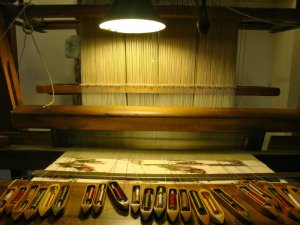- Home
- Resurrection ▾
-
Learn ▾
- Free library
- Glossary
- Documents
- Initiation
-
Shaped fabrics
- Introduction
- Popularization
- Definitions
- Le métier de façonné
- Principes du façonné
- Mécaniques de façonné
- Le jeu des crochets
- Les cartons
- Chaîne des cartons
- Mécanique 104 en détail
- Pour en finir
- Montage façonné
- Empoutage 1/3
- Empoutage 2/3
- Empoutage 3/3
- Punching, hanging and dip
- Autres façonnés
- Façonnés et Islam
-
Cours de tissage 1912
- Bâti d'un métier
- Le rouleau arrière
- Les bascules
- Formation du pas
- Position de organes
- Mécanique 104 Jacquard
- Fonctionnement 104
- Lisage des cartons
- Le battant du métier
- Le régulateur
- Réduction et régulateur
- Mise au métier d'une chaîne
- Mise en route du métier
- Navettes à soie
- Battage
- Ourdissage mécanique
- Préparation chaînes et trames
- Equipment ▾
- Chronicles ▾
- Fabrics ▾
- Techniques ▾
- Culture ▾
- Language ▾
The brocade is a shaped fabric, formed by a special weave, which allows the most valuable materials to be used without loss of weaving, so this method is the only one used to use as a weft , Gold and silver spun in conjunction with silk. We can distinguish several kinds of brochures.

Hardcover
The simple sketch is a partial weaving which differs so much from the lance, that there is nothing to be misunderstood, since, by means of the pound, shapes are formed on the fabric, detached more or less from one another Of the others, without there being a single flange. Also, the molded shapes have on those launched various advantages that give them priority over all these kinds of fabrics. They are all the more sought after, since they are not subject to cutting, and they offer a solidity which is infinitely superior to the articles thrown and cut. One of the greatest advantages of paperbacks is that by this kind of weaving it is possible to divide the same stroke of weft into different materials and colors, each of which will occupy their respective positions. This will be readily understood by the details which will follow.Let us suppose an article in six paths, on each of which we would like to execute a molded effect, such would be, for example, a small isolated and contracted flower. During the crowd which will take place for the cuttings which are to form the fabric formed on the same line, one can, at each lift, pass three colors or different materials on the same blow. For this purpose, very small boxwood shuttles are used, to which the name of espolin is given.Assuming that in this example each effect or each flower is entirely established by 7 different colors, it will be necessary to use as many sets of espolins as possible for the execution, A series of espolins must be placed on the face, in front of the subject which it is called to make.
The passage of each espolin forms a quantity of zigs-zags which take place on the lifting of the lats which are designated to them. These lats are additional to the background, which is always de rigueur. This is evident, since the wefts that make up the fabric are woven only by the paper, it is necessary that the binding of one flower to the other, which constitutes the body of the fabric, is made by a Or by several strokes of the ground, the emergence of which can be indiscriminately established either by the body or by helices arranged accordingly.When the broached parts are provided in weft, they form a very sensitive convexity, especially when the gilding dominates there. In this case it is urgent to wrap on the front roller, and at the same time as the fabric, a thick and soft fabric called a fleece. Without this precaution, the broached parts were flattened during the winding, which would have the double disadvantage of crushing the drawing and of scuffing the bottom (Note: do not take this into account if using a Indirect multi-roller front winding system).
Soft-launched
The name of the book is given to the fabrics, the manufacture of which is established jointly by the effects of one and the other, in this case the brocade is specially made for gilded, silver or silk wefts, A very high price, while the effects produced by the launch are reserved for the lower frames.
Paperback-Damask
The damask paper is nothing more than an ordinary embroidered stuff set on a damask background. The drawings arranged for this kind are usually arranged so as to form the enclosure of the paper. Articles are also made which combine the brocade, the lance, and the damask. For this type of assembly, it is enough to arrange each part individually, that it would be done if it were only one.
Paperback-crocheted
The broché-crocheté is still very little in use. For this kind of weaving, each stroke of weft may be formed by any number of espolins, which produce on the fabric as many different colors, and on the same line. To execute this kind of book, the weft of each espolin must cross with that of the espolin which adjoins it, that is to say that all the weft loops which terminate an effect are, on the right and on the left , Crocheted with the loops of frames which form the effect which is contiguous to them. This kind of fabric has the one drawback of requiring a lot of labor, which brings it to an excessively high price, so it has rightly been dubbed the KING OF FABRICS.
Conclusion:
From what we have just said in the pamphlets, we understand that the variety of these articles may extend to infinity: besides, whatever the genus, the process of weaving is always about the same.